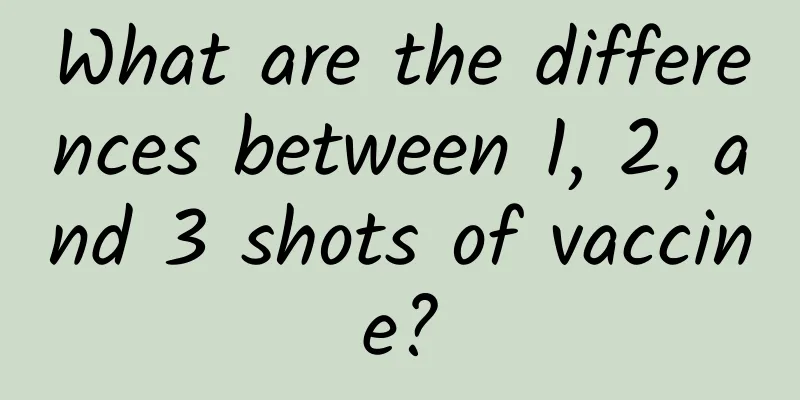What are the differences between 1, 2, and 3 shots of vaccine?

|
Some COVID-19 vaccines require three shots, some require two shots, and some require one shot. This is because vaccines with different technical routes have different characteristics. But their purpose is only one, to ensure effectiveness and safety. Author: Xu Sijia, Kyoto University School of Medicine, Japan Have you finished the COVID-19 vaccine? Recently, a vaccine that only requires one shot has been put into use in Shanghai. Many friends have wondered: Why do I need two shots? Some people need three shots. What's going on? In fact, this is determined by the type of vaccine. Vaccines stimulate the immune system to produce antibodies. Different types of vaccines have different characteristics, and the duration they last in the human body and the degree of stimulation to the immune system are also different. Therefore, the number of vaccinations is also different. The specific number of vaccinations and plans for different vaccines are determined based on the results of previous clinical studies. The purpose is to obtain the best immune effect. Therefore, the vaccination procedure should be completed as much as possible within the recommended interval. So, what is the difference between one, two, and three shots of vaccine? Common 2-dose vaccine: inactivated vaccine First, let's introduce the most common and widely used two-shot vaccine, which is called an inactivated vaccine, also known as a dead vaccine. It is one of the vaccines with the most traditional process. Its raw material is the virus itself. The virus protein is coagulated by physical or chemical methods to remove its infectious activity, but it still retains the "appearance" characteristics that can be recognized by the human immune system. It is like making a ferocious beast into an immobile specimen. It is not pathogenic but can stimulate the immune system to produce antibodies. Its stability and safety are relatively reliable. However, the dead vaccine cannot reproduce in the human body and the stimulation time of the immune system is short, so it needs to be vaccinated multiple times to achieve the ideal effect. The recommended basic immunization program for the inactivated COVID-19 vaccine is 2 doses, with an interval of 3 to 8 weeks. The first dose can stimulate the body to produce a partial immune response, while the second dose can produce a better immune effect. Currently, there are three inactivated COVID-19 vaccines approved for conditional marketing in my country, which have been widely used at home and abroad for more than 250 million doses (data from May 2021). Inactivated vaccines are the most traditional and widely used. |Source: Internet New vaccine: adenovirus vector vaccine The new vaccine is an adenovirus vector vaccine. This is a live vaccine. Completely different from the inactivated vaccine process, it uses a modified non-pathogenic adenovirus as a vector and then loads the representative gene fragment of the new coronavirus, just like a cargo truck. After being injected into the human body, the vector adenovirus uses human cells to synthesize a large amount of characteristic proteins of the new coronavirus based on the information it carries, activating the immune response. After that, with each replication, it will continue to stimulate the immune system and form a longer-lasting immune memory. The current basic immunization regimen for adenovirus vector vaccines is 1 dose. Since it takes 6 months to evaluate the duration of antibodies in clinical trials, it is a little late compared to inactivated vaccines. On May 13, Shanghai first started the vaccination of adenovirus vector vaccines. This vaccine was jointly developed by CanSino Biologics and the team of Academician Chen Wei from the Institute of Bioengineering, Academy of Military Medical Sciences, Chinese Academy of Military Sciences, and is the world's first COVID-19 vaccine to enter clinical trials. Vaccine that requires 3 injections: Recombinant protein vaccine The vaccine that requires three shots is a recombinant new coronavirus vaccine, also called a recombinant protein vaccine. It uses bioengineering technology to directly produce the characteristic proteins of the new coronavirus in vitro, which can also be recognized by the human immune system and produce corresponding antibodies. Ye Sheng, secretary-general of the Science Popularization Working Committee of the Chinese Biophysical Society, introduced that "the production process of the recombinant protein vaccine does not involve the complete new coronavirus (inactivated vaccine) and does not require any virus as a vector (adenovirus vector vaccine), so it has the highest safety." In addition, the adverse reaction rate of this vaccine is relatively low, and the transportation and storage conditions are not demanding. A refrigerated environment of 2 to 8 degrees Celsius is sufficient. However, "because the recombinant protein vaccine is not a complete virus, our immune system does not regard these small proteins as a major threat, but through repeated vaccinations, our immune memory can be strengthened, thus having the ability to provide immune protection." Currently, recombinant protein vaccines are administered in 2 to 3 injections. The recommended interval between two doses is ≥ 4 weeks. The second dose should be administered within 8 weeks after the first dose, and the third dose should be administered within 6 months after the first dose. On March 18 this year, the recombinant protein vaccine jointly developed by the Chinese Academy of Sciences and Zhifei Biopharma was approved for emergency use, and has recently been opened to more people in Chongqing, Xi'an and other places. Another recombinant protein vaccine developed by Sinopharm Group was also approved for clinical trials on April 9 this year, and the first injection of the clinical trial was completed in Ningling County, Shangqiu, Henan on April 25. The three-shot vaccine is not only safe to produce, but also has a high yield, which can alleviate the current vaccine shortage. |Source: Internet Many friends may have questions about your most concerned issues: Which vaccine should I choose? Can I mix them together or take more than one vaccine? Here are some of them. Which vaccine should I choose? Although the principles, preparation methods and vaccination procedures differ, the vaccines currently used are almost the same in terms of administration method (injection into the deltoid muscle of the upper arm), age range (18 years old and above), safety and final immune effect (both meet the protective efficacy requirements of the WHO and my country's Center for Drug Evaluation CDE). Although only one shot was given, 28 days after a single injection of the adenovirus vector vaccine, the vaccine's overall protective efficacy against all symptoms was 65.28%, and its protective efficacy against severe diseases was 90.07%. Shao Yiming, a researcher at the Chinese Center for Disease Control and Prevention, introduced that for people who have temporary or urgent tasks to go to the epidemic area but do not have enough time to wait, or cannot guarantee subsequent vaccination for various reasons, a single-shot adenovirus vector vaccine is more suitable. Many people think that a single-shot adenovirus vector vaccine with only one shot is "more powerful". In fact, strictly speaking, the intensity of the immune response induced by the vector vaccine is weaker than the overall effect of the two-shot vaccine. There is no problem in preventing early epidemic viruses, but the protection efficiency will mostly decrease when the virus mutates in the later stage. The Phase I and Phase II clinical trials of the recombinant protein subunit new coronavirus vaccine (Chinese Academy of Sciences-Zhifei) have not shown any serious adverse events related to the vaccine. After 2 doses of the vaccine, 76% of people can produce neutralizing antibodies, and after 3 doses of the vaccine, 97% of people can produce neutralizing antibodies. II. If the follow-up injection does not catch up with the recommended time, do I have to start from the beginning? No, you can complete the corresponding doses as soon as possible. For example, if you have received one dose of inactivated vaccine, you should continue to receive the same inactivated vaccine to complete the full course. The same applies to the recombinant inactivated vaccine that needs to be completed in three doses. If you go to other places and there are special circumstances where there are no products from the same company and the same technical route to supply, it is recommended to replace them with products of the same technical route, such as replacing inactivated vaccines with inactivated vaccines. It is not recommended to use other types of vaccines for replacement. III. Can I get more than one type to improve the protection rate? Regarding the use of several vaccines for alternating vaccinations, the academic community has indeed proposed similar ideas. For example, in the future, the vaccination procedure can be optimized in terms of doses, dosages and vaccination intervals, and "sequential vaccination" can be tried in order to enhance the body's immune response. Similar strategies have been used in the prevention and control of the Ebola virus before. At a press conference held by the Joint Prevention and Control Mechanism of the State Council on May 20, Wang Huaqing, chief expert of the immunization program of the Chinese Center for Disease Control and Prevention, said: This strategy has not been tested on the new crown vaccine, and its effectiveness and safety are still in the stage of data accumulation. Therefore, the current recommendation is not to mix vaccinations. For example, for those who have received two doses of inactivated vaccines, it is not recommended to use adenovirus vaccines for reinforcement. Editor | Dai Jingshi Gao Peiwen The article is published by "China Science and Technology Press" (ID: cspbooks). Please indicate the source when reprinting. |
<<: Why is chess called Xiangqi? Who is the first Chinese female chess grandmaster?
Recommend
Can I eat milk that has swollen overnight?
During the lactation period, especially right aft...
What is the structure of the uterus?
As we all know, the uterus is a very important pa...
What to do if the vulva is itchy at 37 weeks of pregnancy
Vulvar itching may occur in the late pregnancy. I...
What should I pay attention to after ovarian cyst surgery?
Women's ovaries are very important to women. ...
Is vasectomy harmful to women's health?
In real life, in order to avoid unmarried pregnan...
The hose is not smooth
Getting married and having children is every woma...
What to do if your breasts sag?
Breast problems are a major issue that many women...
Can you get pregnant ten days before your period?
For women, getting pregnant with a healthy baby i...
Is it normal to have menstruation on 26 days?
Women's menstruation often changes. Sometimes...
Who should not get cervical vaccination?
Cervical cancer is very scary for women, and the ...
Can cervical erosion be cured by taking medicine?
With the development of medical technology, there...
Is there anything particular about what the bride should step on when getting out of the car? What's the matter with wrapping the groom around a tree with tape?
Nowadays, when people get married in rural areas,...
Women experience lower abdominal pain after holding urine
We have all encountered this situation, having th...
In vitro fertilization egg and sperm retrieval: Parents’ cleanliness obsession can save the baby’s life!
Author: Chen Weiwei, Chief Technician, Sichuan Ji...
Precautions after cervical laser surgery
If a woman suffers from cervical erosion, in addi...


![[Medical Q&A] HIFU is effective, why doesn’t the doctor recommend it to me?](/upload/images/67f1162d55505.webp)






